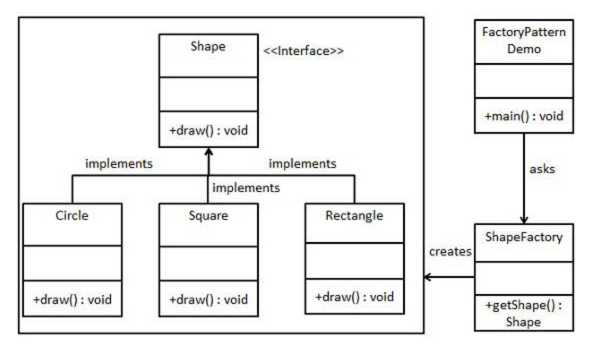标签:
Factory Pattern , 即工厂模式,用于创建对象的场景,属于创建类的设计模式 。
下面是一个工厂模式案例。 Shape 作为接口, Circle, Square, Rectangle 作为具体类实现了 Shape 接口。 ShapeFactory 封装了创建各个 Shape 的方式,隐藏了 new 命令。FactoryPatternDemo 用于演示工厂模式。

具体代码:
Shape 接口定义
public interface Shape { public void draw(); }
Circle / Rectangle / Square 三个具体类的实现,实现 Shape 接口
public class Circle implements Shape { @Override public void draw() { System.out.println("Circle - draw"); } }
public class Rectangle implements Shape { @Override public void draw() { System.out.println("Rectangle - draw"); } }
public class Square implements Shape{ @Override public void draw() { System.out.println("Square - draw"); } }
ShapeFactory 工厂类,根据传入的参数,即Shape 的具体名称,来创建返回对象
public class ShapeFactory { public static Shape getShape(String shapeName){ Shape shape = null; if ("Circle".equals(shapeName)){ shape = new Circle(); } else if ("Rectangle".equals(shapeName)){ shape = new Rectangle(); } else if ("Square".equals(shapeName)){ shape = new Square(); } return shape; } }
使用演示
public class FactoryPatternDemo { public static void main(){ Shape circle = ShapeFactory.getShape("Circle"); circle.draw(); Shape rectangle = ShapeFactory.getShape("Rectangle"); rectangle.draw(); Shape square = ShapeFactory.getShape("Square"); square.draw(); } }
个人理解
本案例的优点有:
1. FactoryPatternDemo 作为工厂模式的使用方,使用 Shape 接口来声明变量,避免和具体实现耦合,这是针对接口编程的体现。
2. Shape 对象的创建(new) 都被封装在 ShapeFactory 里面,FactoryPatternDemo 无需使用 new 命令即可获得新对象。这有利于后期拓展维护。
拓展时,涉及的变动文件:
例如,在系统中需要增加一个三角形对象 triangle 。
1. 增加一个文件,实现 Trianlge 类, 使其实现 Shape 接口,实现 draw() 方法
2. 在 ShapeFactory::getShape() 方法中增加支持 Triangle 的调用。
这样调用方即可使用新增的 Triangle 对象。
参考资料
Design Pattern - Factory Pattern
[Design Pattern] Factory Pattern 简单案例
标签:
原文地址:http://www.cnblogs.com/TonyYPZhang/p/5514536.html